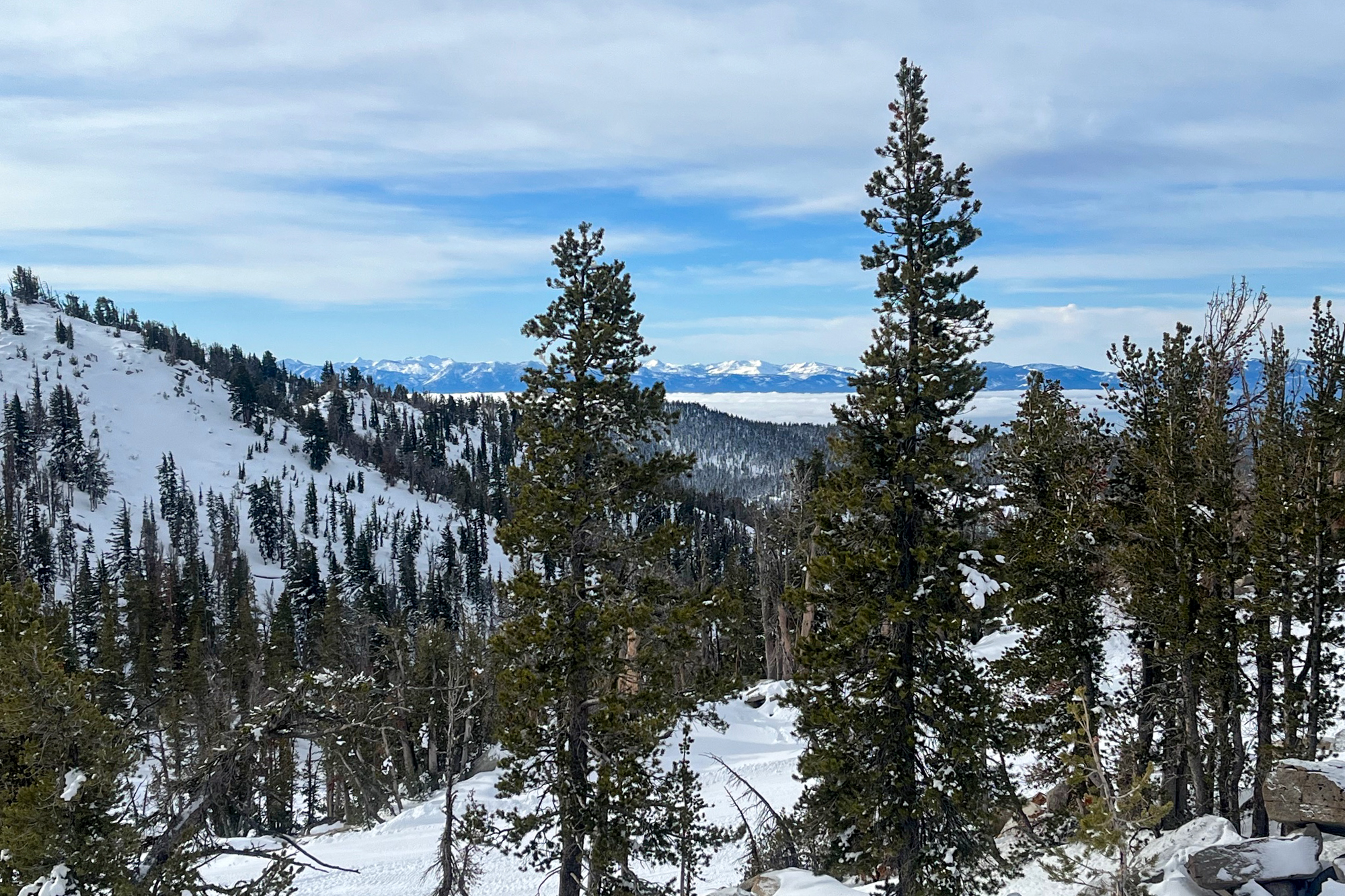Much of Nevada started 2024 with an abysmally low snowpack. Odds of it recovering are slim

Good morning, and welcome to the Indy Environment newsletter. I'm Amy Alonzo, the environment reporter for The Indy.
Everyone has a different perspective on snow.
Trying to commute between Reno and Fernley on Interstate 80? Stay away, white stuff.
A skier looking for a fresh stash? Bring on the powder!
Whatever your feelings on snow, one thing is inescapable — the West is toast without it.
Last winter, the storms seemed endless. This year, at least in western Nevada, winter seemed to come and go in a one-week span just after New Year’s. In my yard, bulbs are popping up, along with a bumper crop of weeds. Yesterday, I worked in the garden in flip flops — not my usual January footwear. I’m hoping for snow — for our water table and to put a kibosh on my crop of weeds.
As always, we want to hear from readers. Let us know what you’re seeing on the ground and how policies are affecting you. Email tips to me at [email protected].
To get this newsletter in your inbox, subscribe here.

Last winter, 32 atmospheric rivers — intense storms that carry moisture from the tropics — blew over California and into Nevada, dropping voluminous snow and rain.
The atmospheric rivers brought record snowfall to much of Nevada and a reprieve from three consecutive years of drought. After more than two decades of nearly continuous decline, water levels at Lake Mead started ticking upward. In December, the National Weather Service’s Climate Prediction Center estimated that Nevada’s remaining drought designations are likely to lift by the spring.
Hopes were high that this winter would be another big snow year, akin to the early ’80s when the Sierra Nevada saw a strong snowpack over three consecutive winters.
That’s not how 2024 is shaking out so far for much of Nevada. Snowpack is below normal across most of western Nevada and Southern Nevada, as well as regions outside the state that are critical to the state’s water supply, such as the upper Colorado River Basin and Sierra Nevada.
There are more than 150 types of drought, including meteorological droughts, where areas have reduced precipitation; snow droughts, when precipitation falls, but as rain instead of snow; and hydrologic droughts, when reservoirs run low.
While nearly all areas in Northern Nevada are free of hydrologic drought due to holdover reservoir storage from last year, Nevada is experiencing a mix of conditions this winter, said Jeff Anderson, Nevada hydrologist and water supply specialist for the Natural Resources Conservation Service Snow Survey program. The Sierra Nevada, the primary water source for the Reno-Carson area, and the Spring Mountains outside Las Vegas are experiencing a meteorological drought coupled with a snow drought, especially at lower elevations. Between October and December, Reno saw just 0.72 inches of rain, 1.5 inches below normal. Combined, Winnemucca and Las Vegas barely received an inch.
At the same time, temperatures have largely been warmer. Nevada saw its 16th warmest period from October to December since 1895, Dan McEvoy, Desert Research Institute associate research professor, said at a January drought and climate webinar hosted by the National Integrated Drought Information System (NIDIS.)
The combination of reduced snowfall and warm temperatures, which bring rain instead of snow to lower elevations when storms do hit, means it will be hard — although not impossible — to catch up.
Recalling the Western drought of 1977
The water year is measured from Oct. 1 to Sept. 30. This January, some snow-measuring sites in Nevada, as well as other Western states, were at record lows.
The Carson River Basin started the calendar year at 38 percent of its median snowpack, compared to 241 percent at this time last year. The Lake Tahoe Basin started at 42 percent — last January, it was at 215 percent.
It’s not just Nevada — much of the Western United States started the year off dry. This has ramifications in the Silver State, whose major population centers rely on snow that falls in California’s Sierra Nevada and as far away as Colorado and Wyoming in the upper Colorado River Basin.
The snowpack has improved in the upper Colorado River Basin over the past several weeks, but downstream, Lake Powell and Lake Mead, which combined can store about 50 million acre-feet of water, have about 33 million acre-feet of storage capacity sitting empty.
“To totally fill those reservoirs, it would take 6.5 winters like we had last year,” Anderson said. “You can’t get into a 24-year drought and get out of it in one year. It would really be a huge shift in what the climate’s been doing to fill those reservoirs again.”
Seeing most Western states start the year dry recalls 1977, when the West collectively saw one of its worst snowpacks, Anderson said.
“Typically, one part of the country’s getting storms, and another isn’t,” he said. “To see it be [dry] across the entire West is pretty unusual.”
There are pockets of the state where the snowpack is better — the Owyhee River and Snake River basins in far northeastern Nevada are at median, and central Nevada basins have received decent precipitation thus far. Western Nevada reservoirs such as Lahontan, which is sitting at 73 percent of capacity, twice the amount it would normally have at this time of year, are looking good, Anderson said.

Hopes of a strong El Niño
In June, National Oceanic and Atmospheric Administration forecasters announced El Niño was here. El Niño climate patterns bring warmer-than-average temperatures in the Pacific Ocean near the equator with far-reaching weather impacts. In the United States, El Niño’s influences are most pronounced in the winter and spring.
The last El Niño, in 2019, brought coastal flooding and some of the deepest recorded snowpacks in the Sierra Nevada, Michael Anderson, state climatologist for the California Department of Water Resources, said during the NIDIS webinar.
El Niño doesn’t always mean heavy precipitation for the Sierra Nevada, he said. Of the seven El Niño events this century, two were dry, three were near average and two were very wet.
But El Niño predictions usually stack the deck toward greater-than-normal precipitation in Southern Nevada. This January, the snowpack in the Spring Mountains didn’t even measure in the double digits — it measured just 9 percent of median.
For the Sierra Nevada, El Niño brings a 33 percent chance of a good winter, a 33 percent chance of a normal winter or a 33 percent chance of a bad winter.
“The good news is, it doesn’t matter what the Pacific’s doing, we still have a 33 percent chance of getting a big winter. It’s not a predictor of what our winter’s going to be,” Jeff Anderson said.
A “Miracle March” could still save the day, he said, similar to 2018 when the Sierra Nevada’s snowpack increased about 50 percent just in the month of March. But the odds are slim.
“It’s really impossible to say what’s going to happen this year,” he said. “It’s possible we could recover to a great degree, but the chances of that happening are kind of exceptional.”
Studying past water years shows the odds are about 20 percent that the Sierra Nevada will receive enough snow to reach median snowpack by April 1 and 30 percent in the upper Colorado River Basin. The Humboldt Basin in Northern Nevada has a 50 percent chance.
“If we end up below average, everyone’s going to start asking, ‘What about next year?’’ Michael Anderson said.

Here’s what else I’m watching this week:
Former Indy reporter Daniel Rothberg writes about an important Nevada Supreme Court decision and the ramifications it could have on statewide water resource management.
Conservationists are looking to permanently ban mineral claims in the Amargosa Desert, according to the Nevada Current.
Tree ring samples offer insight into the West’s most recent drought, The Washington Post reports.
Rep. Dina Titus (D-NV) petitioned the federal government to reconsider plans to gather nearly 21,000 wild horses this year in the West, the Las Vegas Sun reports.
Oregon Public Broadcasting reports on the ongoing removal of dams on the Klamath River.
An in-depth look at lithium mining and water use from the Howard Center for Investigative Journalism at Arizona State University.
